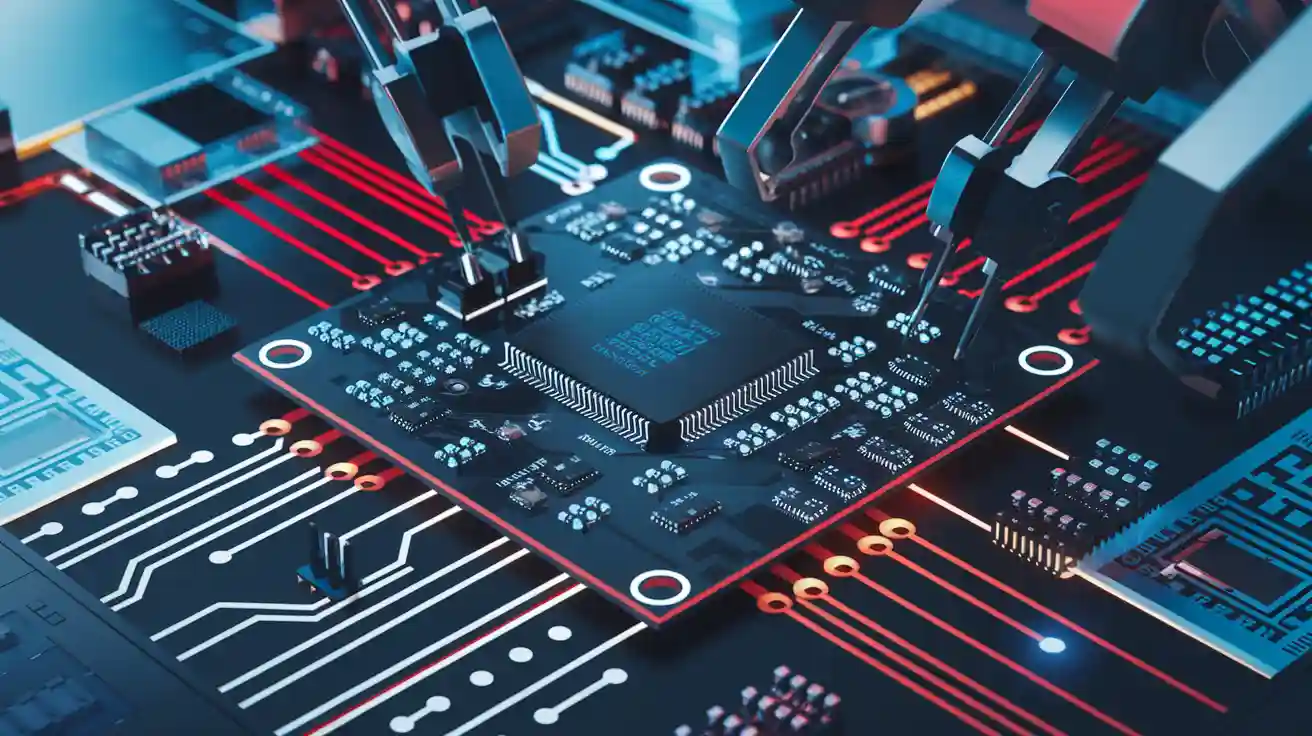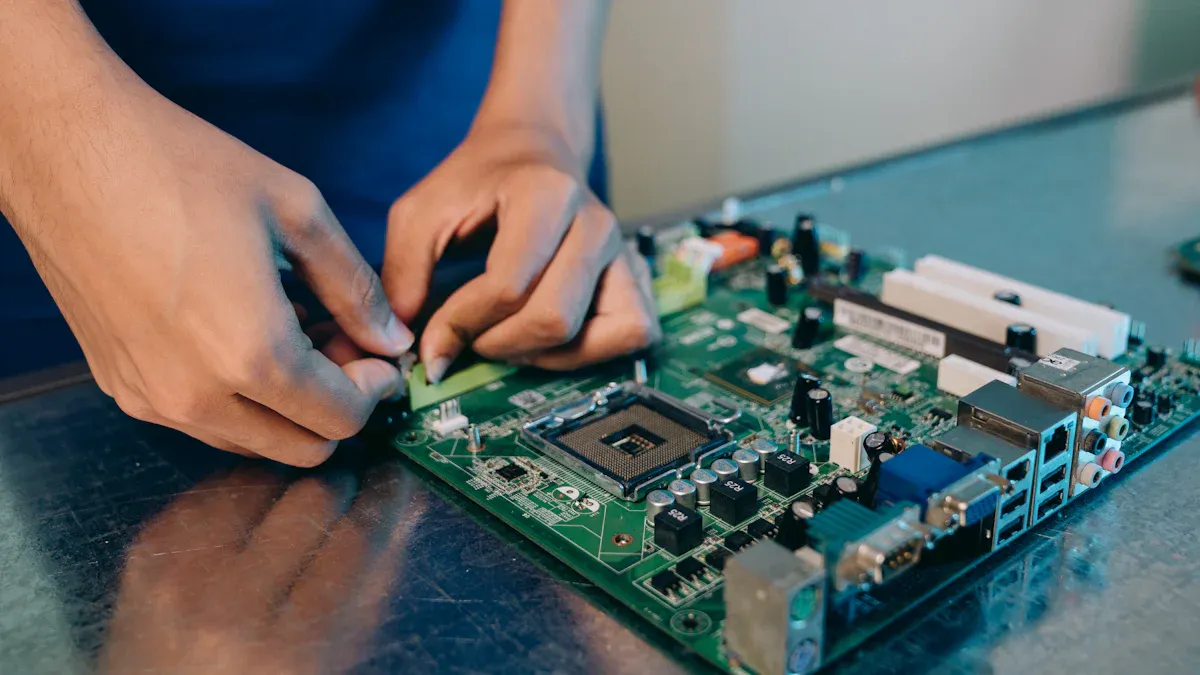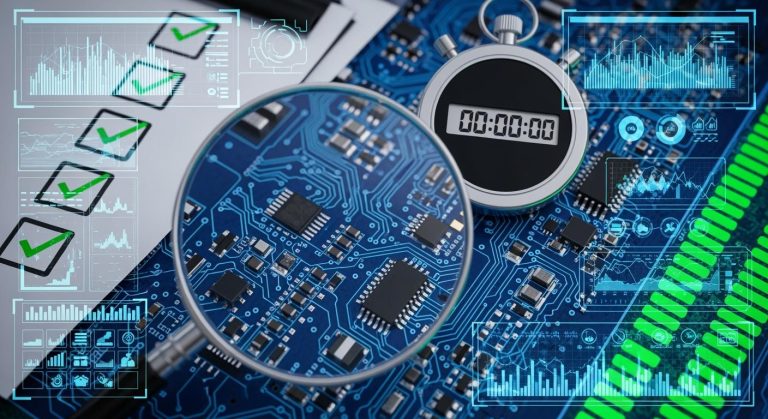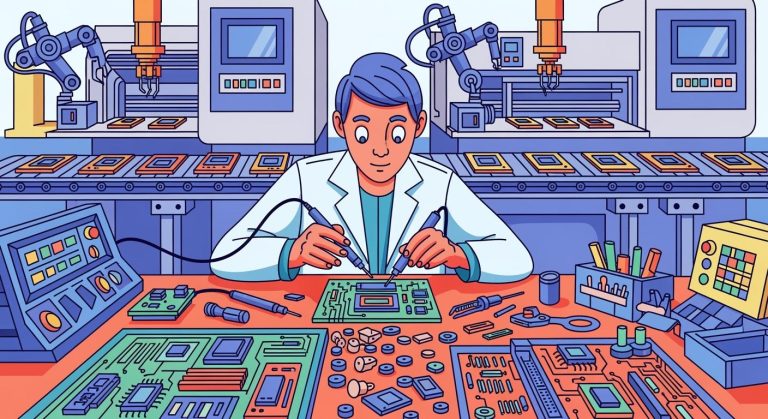SMD and SMT Compared for Modern PCB Assembly
Surface Mount Devices (SMD) represent the components that populate modern printed circuit boards (PCBs), while Surface Mount Technology (SMT) defines the process used to mount these components. Together, they transform PCB assembly, enabling compact designs with exceptional performance.
📈 The adoption of SMT technologies continues to rise, driven by the demand for miniaturized consumer electronics.
- The global SMT market is projected to grow from USD 5.8 billion in 2023 to USD 8.4 billion by 2028, with a 7.8% compound annual growth rate (CAGR).
- Innovations in consumer electronics require smaller, more efficient hardware, fueling SMT’s popularity.
- Inspection equipment within SMT assembly processes is expected to expand at the highest CAGR, reflecting advancements in quality assurance.
By understanding SMD and SMT, you can unlock their potential to streamline your PCB designs and meet the demands of cutting-edge electronics.
Key Takeaways
- SMDs allow small designs and many parts, perfect for gadgets like smartphones and IoT devices.
- SMT makes building faster and more reliable with machines doing the work.
- Think about your project needs, like cost and design difficulty, when picking SMD or SMT.
- Using better SMT methods can make products last longer and have fewer problems.
- Knowing the pros and cons of SMD and SMT helps make better PCBs for different uses.
Understanding SMD in PCB Assembly
What Is SMD?
Surface mount devices (SMD) are electronic components designed to be mounted directly onto the surface of a printed circuit board (PCB). Unlike traditional through-hole components, SMDs do not require leads to pass through drilled holes in the PCB. Their compact design allows for higher component density, making them ideal for smaller electronics. Industry standards, such as IPC-A-610 and IPC-J-STD-001, ensure the quality and reliability of SMD assemblies. These standards cover aspects like solder joint inspection and handling of moisture-sensitive components, ensuring consistent performance across applications.
Role of SMD in Modern Electronics
SMDs play a pivotal role in modern electronics by enabling miniaturization and enhancing efficiency. For example, SMD Zener Diodes regulate voltage in densely populated circuit boards, ensuring reliable operation in compact devices. Similarly, SMD inductors support applications ranging from consumer electronics to automotive systems, contributing to energy efficiency and space-saving designs. Over 80% of components used in PCB assemblies are surface-mount devices, underscoring their prevalence in the industry. Innovations like the SolderlessPCB approach further simplify assembly and disassembly, allowing for easier reuse of SMD components.
Advantages of SMD
SMDs offer several advantages that make them indispensable for modern PCB designs:
- High component density: Their smaller size allows more components to fit on a single PCB, enabling compact and high-performance designs.
- Faster assembly time: Automated processes eliminate manual insertion, speeding up production and reducing labor costs.
- Enhanced reliability: SMDs are less prone to mechanical stress due to their lack of leads, improving durability in high-vibration environments.
- Compatibility with automation: Their design supports automated assembly techniques, ensuring consistent quality and scalability for mass production.
These benefits make SMDs the preferred choice for smaller electronics, where space and efficiency are critical.
Disadvantages of SMD
While surface mount devices (SMD) offer numerous advantages, they also come with certain limitations that can impact their usability in specific scenarios. Understanding these drawbacks is essential for making informed decisions during PCB assembly.
One of the primary challenges with SMDs is their repairability. Due to their small size and close placement on PCBs, repairing or replacing these components can be difficult. Hand-soldering SMDs requires precision and specialized tools, which increases repair costs and complexity. Additionally, the compact design often leaves minimal space between components, further complicating repairs.
Another significant limitation is their handling difficulties. SMDs are much smaller than traditional through-hole components, making manual handling almost impossible. Specialized equipment is necessary for accurate placement and soldering, which adds to the overall cost of production. This reliance on advanced machinery can be a barrier for smaller manufacturers or DIY enthusiasts.
SMDs are also more susceptible to thermal stress and physical damage. Their compact structure makes them less robust compared to through-hole components. High temperatures during soldering or thermal cycling can weaken solder joints, increasing the risk of failure over time. This limitation is particularly concerning in applications that involve frequent temperature fluctuations or mechanical stress.
The table below summarizes these disadvantages:
| Limitation | Description |
|---|---|
| Repairability | Small lead spaces and compact placement make repairs challenging and costly. |
| Handling Difficulties | Manual handling is difficult, requiring specialized equipment for placement and soldering. |
| Thermal Stress Susceptibility | SMDs are prone to damage from high temperatures or physical stress. |
| Thermal Cycling Issues | Solder connections may fail under repeated thermal cycling. |
Despite these challenges, SMDs remain a cornerstone of modern electronics. By addressing these limitations through careful design and advanced manufacturing techniques, you can still leverage their benefits effectively.
Exploring SMT in PCB Assembly
What Is SMT?
Surface Mount Technology (SMT) is a manufacturing method where electronic components, known as surface mount devices (SMD), are mounted directly onto the surface of a printed circuit board (PCB). Unlike traditional through-hole technology, SMT eliminates the need for drilling holes, enabling more compact and efficient designs. This process supports high-density layouts, making it ideal for modern electronics like smartphones, automotive systems, and telecommunications equipment. SMT relies heavily on automation, ensuring precision and scalability for high-volume production.
Key Steps in the SMT Process
The SMT process involves several critical steps to ensure accurate and reliable PCB assembly:
- SMC and PCB Preparation: Prepare the surface mount components (SMC) and clean the PCB to remove contaminants.
- Solder Paste Printing: Apply solder paste to the PCB using a stencil to define the areas where components will be placed.
- Components Placement: Use automated pick-and-place machines to position SMDs onto the solder paste.
- Reflow Soldering: Heat the PCB in a reflow oven to melt the solder paste, creating secure electrical connections.
- Cleaning and Inspection: Remove excess flux and impurities, then inspect the assembly for defects using automated optical inspection (AOI) or X-ray systems.
These steps ensure a streamlined process, reducing errors and enhancing the quality of the final product.
Benefits of Surface Mount Technology
SMT offers numerous advantages that make it indispensable for modern PCB assembly:
- Compact Designs: SMT components are smaller than through-hole counterparts, allowing for higher component density and efficient use of PCB space.
- Faster Manufacturing: Automated placement and soldering processes enable rapid production, making SMT ideal for large-scale manufacturing.
- Improved Reliability: SMT components are less prone to failure from vibration or shock due to their low profile and secure soldering.
- Versatility: SMT supports mixed technology PCBs, combining surface mount and through-hole components for diverse applications.
- High-Density Designs: The use of fine-pitch elements enables the creation of complex, high-performance systems.
These benefits make surface-mount technology a cornerstone of industries ranging from consumer electronics to aerospace, where precision and efficiency are paramount.
Challenges of SMT Implementation
Implementing SMT can revolutionize your PCB assembly process, but it comes with its own set of challenges. These hurdles often require careful planning and investment to overcome, especially as surface mount technology becomes more advanced and widespread.
One of the most significant challenges is the high capital outlay required for equipment. Automated placement machines, essential for SMT, can cost anywhere from USD 9,000 to USD 37,500. This expense can be a barrier for small and mid-sized manufacturers looking to adopt surface-mount technology. You must weigh these costs against the long-term benefits of automation and efficiency.
Another common issue is the persistent skill shortages in the industry. Training operators to handle SMT equipment effectively can be time-consuming. Without skilled personnel, you may face extended changeover times and reduced production yields. Investing in comprehensive training programs can help mitigate this challenge, but it adds to the overall implementation cost.
Integration complexity also poses a significant hurdle. For instance, 44% of automated optical inspection (AOI) upgrades encounter delays due to compatibility issues with legacy systems. If your facility relies on older equipment, you might need to invest in system upgrades or custom solutions to ensure seamless integration.
Finally, achieving thermal profiling precision is critical for consistent results. Uneven solder joints can lead to defects, with 12% of assemblies requiring rework due to this issue. You need to ensure precise temperature control during the reflow soldering process to maintain yield consistency and reduce rework costs.
Addressing these challenges requires a strategic approach. By understanding the potential pitfalls of SMT implementation, you can make informed decisions and optimize your production process for success.
SMD vs. SMT: Key Differences
Functional Differences Between SMD and SMT
Understanding the functional differences between surface mount devices (SMD) and surface mount technology (SMT) is crucial for optimizing your PCB assembly process. While SMD refers to the components themselves, SMT describes the method used to mount these components onto the PCB. Each plays a distinct role in modern electronics manufacturing.
- SMDs are compact components with finer pitch and shorter lead lengths, which enhance electrical performance. Their small size makes them ideal for high-routing density and compact designs.
- SMT, on the other hand, supports the assembly of these components using automated processes. This method enables smaller PCB designs and supports high-density interconnect (HDI) boards, which are essential for advanced applications like smartphones and IoT devices.
- SMT also improves signal integrity and reduces electromagnetic interference due to shorter traces, making it suitable for high-speed circuits.
In contrast, traditional through-hole technology (THT) provides stronger mechanical bonds but requires larger board space. While THT is better for applications exposed to mechanical stress, SMT excels in high-speed, high-density designs.
💡 Tip: If your project demands compact, high-performance designs, SMT paired with SMDs offers unmatched efficiency and scalability.
Cost Comparison of SMD vs. SMT
When comparing costs, you must consider both the components (SMD) and the assembly method (SMT). SMDs are generally more affordable due to their smaller size and compatibility with automated assembly. SMT further reduces costs by streamlining the manufacturing process.
| Cost Factor | SMD | SMT |
|---|---|---|
| Component Cost | Lower due to smaller size and mass production | Reduces overall costs through automation |
| Equipment Investment | Minimal for SMD components | High initial investment for automated machines |
| Labor Costs | Reduced due to automation | Significantly lower compared to manual assembly |
| Repair and Rework Costs | Higher due to handling challenges | Moderate, depending on defect detection systems |
Germany’s high labor costs make SMT an attractive option for reducing production expenses. By outsourcing PCB manufacturing and assembly to China’s King Field, you can leverage advanced SMT processes at a fraction of the cost. This approach ensures high-quality production while maintaining budget efficiency.
Complexity and Implementation Challenges
Implementing SMT and working with SMDs introduces unique challenges. You must address these complexities to ensure a smooth manufacturing process.
- Precision Requirements: SMDs are smaller and require precise placement. Automated pick-and-place machines are essential for accuracy, but they demand significant investment.
- Thermal Profiling: SMT relies on reflow soldering, which requires precise temperature control. Inconsistent thermal profiles can lead to solder defects, increasing rework rates.
- Skilled Workforce: Operating SMT equipment and handling SMDs requires specialized training. A shortage of skilled labor can slow down production and reduce yields.
- Integration with Legacy Systems: Upgrading to SMT often involves compatibility issues with older equipment. This challenge can delay implementation and increase costs.
Despite these challenges, SMT remains the preferred choice for high-volume, high-density PCB assembly. By partnering with experienced manufacturers like King Field, you can overcome these hurdles and achieve reliable, cost-effective production.
🔍 Note: Investing in advanced SMT processes not only reduces assembly defects but also enhances the reliability of your final product.
Applications in Modern PCB Assembly
Modern PCB assembly relies heavily on SMT and SMD to meet the demands of various industries. Each application has unique requirements, influencing the choice between these technologies. Understanding these applications helps you optimize your designs for performance, reliability, and cost-effectiveness.
Industry-Specific Applications
Different industries prioritize SMT or SMD based on their specific needs. The table below highlights key examples:
| Industry | Preference for SMT/SMD | Justification |
|---|---|---|
| Military and Aerospace | Through-hole | Preferred for critical components due to higher reliability in extreme conditions. |
| Consumer Electronics | SMT | Dominates due to miniaturization and efficiency in mass production for portable devices. |
| Automotive | SMT | Increasing reliance on SMT for compact and reliable control modules, though through-hole may be used for high-power applications. |
| Industrial Equipment | Combination | Uses both SMT for control electronics and through-hole for durable components needing field replacement. |
Consumer Electronics
In consumer electronics, SMT has become the standard due to its ability to support smaller electronics. Devices like smartphones, tablets, and wearables require compact designs with high component density. SMT enables manufacturers to meet these demands while maintaining cost efficiency. For instance, automated SMT processes allow rapid production of circuit boards for millions of devices, ensuring consistent quality and scalability.
Automotive Systems
The automotive industry increasingly relies on SMT for its control modules and sensors. These components must be compact, reliable, and capable of withstanding harsh conditions. SMT’s precision and ability to create high-density layouts make it ideal for these applications. However, through-hole technology may still be used for high-power components, such as those in electric vehicle charging systems, where mechanical strength is critical.
Military and Aerospace
In military and aerospace applications, reliability takes precedence over miniaturization. Through-hole components are often preferred for critical systems due to their robust mechanical bonds and ability to withstand extreme conditions. However, SMT is gradually being adopted for non-critical systems, where compact designs and weight reduction are advantageous.
Industrial Equipment
Industrial equipment often combines SMT and through-hole technologies. SMT is used for control electronics, where compactness and efficiency are essential. Through-hole components are reserved for parts that require durability and easy field replacement. This hybrid approach ensures reliability while accommodating the diverse needs of industrial applications.
💡 Tip: When deciding between SMT and SMD, consider the specific requirements of your application. Factors like reliability, size constraints, and production volume will guide your choice.
By understanding the applications of SMT and SMD across industries, you can make informed decisions that align with your project’s goals. Whether you’re designing for consumer electronics or industrial systems, leveraging the strengths of these technologies ensures optimal results.
Choosing Between SMD and SMT
When to Use SMD in PCB Assembly
Surface mount devices (SMD) are ideal when your project demands compact designs and high component density. Their small size allows you to fit more components on a single PCB, making them perfect for modern electronics like smartphones, wearables, and IoT devices. If your design requires lightweight and portable solutions, SMDs provide the flexibility to achieve these goals without compromising performance.
In high-volume PCB production, SMDs shine due to their compatibility with automated assembly processes. Manual soldering becomes impractical for large-scale manufacturing, but advanced placement machines ensure precise installation of tiny components. These machines can position SMDs with micron-level accuracy, which is crucial for achieving the reliability and efficiency required in modern electronic designs.
💡 Tip: Use SMDs when space-saving and automation are priorities. Their compatibility with surface mount technology (SMT) ensures faster production and consistent quality.
When to Use SMT in PCB Assembly
Surface mount technology (SMT) is the go-to process for assembling SMDs onto PCBs, especially when you need to streamline production. SMT eliminates the need for drilling holes, enabling faster and more efficient assembly. This process is particularly advantageous for high-density layouts, where traditional through-hole technology would fall short.
You should consider SMT when working on projects that require high precision and scalability. Automated SMT processes, including solder paste application and pick-and-place component placement, reduce errors and ensure consistent results. For industries like consumer electronics, automotive systems, and telecommunications, SMT offers the reliability and speed needed to meet tight production schedules.
In addition, SMT is essential for double-sided PCB designs, where components are mounted on both sides of the board. This capability allows you to create complex circuits without increasing the PCB’s size. However, keep in mind that double-sided assembly incurs higher costs due to additional processing.
🔍 Note: SMT is indispensable for high-volume production and complex designs. Its automation capabilities make it a cost-effective choice for scaling your operations.
Factors to Consider for SMD vs. SMT
When deciding between SMD and SMT, you need to evaluate several factors to ensure the best fit for your project. These considerations include cost, design complexity, and production requirements. The table below outlines key cost factors to help you make an informed decision:
| Cost Factor | Description |
|---|---|
| Number of unique components | More unique components increase costs, but bulk ordering reduces per-component prices. |
| Type of components | All-SMD assembly can be up to 50% more expensive than through-hole assembly. |
| Double-sided vs. single-sided assembly | Double-sided assembly incurs higher costs due to additional processing. |
| Lead pitch on SMD components | Premiums on fine-pitch components vary by manufacturer, affecting costs. |
| BGA assembly costs | Single or double-sided BGA assembly can add 20% to costs. |
| IPC compliance | Higher IPC standards lead to increased costs due to more inspections. |
| ITAR compliance | Compliance with ITAR adds costs related to data and PCB integrity. |
| Automated assembly | Automated processes reduce overall assembly costs despite initial setup expenses. |
To optimize your decision, follow these strategies:
- Select cost-effective SMT components that are readily available and compatible with automated assembly.
- Use surface-mount footprints in your designs to avoid modifications and reduce production time.
- Replace fasteners with SMDs to lower assembly costs.
- Strategically place SMT components to minimize assembly equipment travel distance.
- Limit the number of SMD variants to simplify procurement and inventory management.
By carefully weighing these factors, you can choose the right approach for your PCB assembly needs. Whether you prioritize cost, efficiency, or design complexity, aligning your strategy with project requirements ensures optimal results.
Understanding the differences between SMD and SMT is essential for optimizing your pcb assembly process. SMD refers to the components, while SMT describes the method used to mount them onto the pcb. Together, they enable compact, high-performance designs.
You must evaluate project-specific factors like design complexity, cost, and production scale when choosing between these technologies. SMDs excel in miniaturization, while SMT ensures efficient and scalable assembly. By mastering these technologies, you can enhance your pcb assembly outcomes and meet the demands of modern electronics.
💡 Tip: Align your choice with your project’s goals to achieve the best results.
FAQ
What is the difference between SMD and SMT?
SMD refers to the electronic components mounted on PCBs, while SMT describes the process used to assemble these components. You use SMDs for compact designs and SMT for efficient, automated assembly.
Can SMT handle double-sided PCB designs?
Yes, SMT supports double-sided PCB assembly. Components can be mounted on both sides, enabling complex circuits without increasing board size. However, this process incurs higher costs due to additional processing steps.
Are SMDs suitable for high-power applications?
SMDs work well for low-power and compact designs. For high-power applications, through-hole components often perform better due to their stronger mechanical bonds and ability to handle higher currents.
What equipment is required for SMT assembly?
SMT assembly requires automated machines like pick-and-place systems, reflow ovens, and inspection tools. These ensure precise component placement, soldering, and defect detection, making SMT ideal for high-volume production.
How do you choose between SMD and SMT for your project?
Evaluate factors like design complexity, production volume, and cost. Use SMDs for miniaturization and SMT for efficient assembly. Align your choice with your project’s goals to achieve optimal results.





















